Designer in a gilded cage wants to fly with the flock
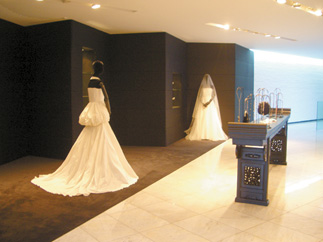
The future wife of a Korean tycoon is advised to wear a formal suit after the ceremony.
But first these bridal aspirants require an introduction to the designer, who, above all others, is known as the wedding gown maker to the jaebeol families of Korea. Once in a while curious passers-by may knock on the glass door of Mr. Suh’s atelier, which glowers across the street at the Seoul Grand Hyatt. They are unlikely to be welcomed. The place looks more like an art gallery than a clothes shop and the door is usually locked. Inside, the sleek and spacious boutique is empty. A couple of mannequins dressed in sumptuous wedding gowns stand in splendid isolation on the marble floor. This is a place where, in the past, an appointment was necessary and asking for the price was declasse. But times are changing. Not that Mr. Suh plans to do anything so vulgar as to make his store popular.
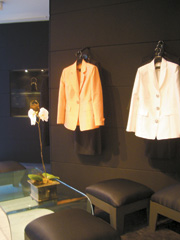
The sublimely simple and elegant wedding gown by Suh Jung-gi made him the fashion designer of Korea’s jaebol class.
His space now covers more than 660 square meters and has everything that Korean high society requires in the way of style ― from dresses to jewelry to bedding to fine art.
Mr. Suh comes by his knowledge of high class desires through direct experience. When he returned to Seoul in 1990, after working for the Anne Klein Design Studio in New York , the first thing he did was to open his boutique. Not many designers can afford to own such a fancy store, but he was connected to the city’s most exclusive social circuit. As the youngest son of a former government minister, he had been a member of Korean high society since birth. Fellow members of his caste flocked to his door.
Mr. Suh takes great care with his clients. He knows that many of their weddings are more like coronations. Unlike middle-class brides who prefer decorative, lacy gowns, his future queens wear highly sophisticated gowns, minimal in detail and understated in trend. Of course, minimal and understated means labor-intensive and pricey. One of the couturier’s signature wedding dresses comes with an endless row of silk buttons that can be opened and closed with an endless row of silk loops. Made with heavy-weight silk, the dress is constructed upon a built-in corset. The dress looks so pure and holy that some wedding guests might think they are seeing an apparition of Botticelli’s Primavera. These gowns start with a sketch selection followed by a muslin fitting. The entire process requires as many as five fittings. “Since Koreans are usually in a hurry, I can make a dress faster, but I need about one- and-a-half to two months to complete it properly,” said the soft-spoken designer.
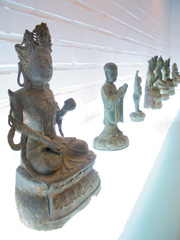
The designer’s latest passion is a collection of Buddha statuettes from Southeast Asia.
Since it is assumed that the bride wears diamonds from her husband’s family, Mr. Suh offers “secondary” jewelry, such as purses embellished with pearls and jade and informal necklaces worn on the honeymoon. It is not the Korean custom for brides to inherit Western-style tiaras, so he has a few crystal crowns on display.
Life as future a jaebeol queen doesn’t end with the wedding day. To design the bride’s new life Mr. Suh invites his clients downstairs. On the staircase wall hangs the 2003 LED sculpture by the American conceptual artist Jenny Holzer. And there is a highly coveted TV installation piece from 1985-86 by the late Paik Nam-june. “All my Paik Nam-june works are from the mid-80s. After that he became ill and his assistant made the works, so the pieces are not as valuable,” he explained in the tone of an art gallery curator. Behind him stands a large Chinese lacquer cabinet matched with an antique Korean tea table.
Around the corner is his office, which also functions as a showroom. It is a real-life room complete with a queen-size bed, side tables and furniture. The white bed is covered entirely with quilted silk. On the side table are stacks of glossy art books. Names like Balenciaga, Bruce Webber, Robert Mapplethorpe, Mario Botta adorn the covers. There are antique marble vanity cases, a Chinese trinket box and a stone sculpture perched on a wire stand.
Opening a silver trinket box, he takes out strands of turquoise beads that he has collected for years. In another box are little green butterflies made of Chinese jade, which he purchased during a trip to China. He picks up an old light bulb and says, “I bought this old bulb and took it to Paik Nam-june to sign it. He was reluctant at first but he signed it for me.”
He says the new layout of his famous basement includes a lighted shelf on one side of the wall. Near two black Le Corbusier chairs, he displays a dozen statuettes of Buddha, which are his current favorite items.
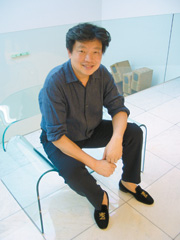
The fashion designer Suh Jung-gi at his Namsan boutique that is decorated with contemporary art works.
All his Japanese chests were moved to the room in the back where his seamstresses work. Only a few Japanese chests decorate a white bathroom wall.
“I took a lot of stuff home,” he says. His highly polished home in Cheongdam-dong, which he shares with his wife, was part of last year’s “Living Room” exhibition at the Daelim Contemporary Art Museum.
Mr. Suh acknowledged that his public reputation was built upon fashion design, but he wishes to be known as a lifestyle designer in the future, with an extensive home collection, somewhat in the manner of Ralph Lauren or Calvin Klein, only much more upmarket. “When they sell bedding and plates, they are not directly involved in manufacturing but collaborate with companies specializing in such products,” he said. “I make lighting fixtures and bedding to order from those who know me and understand my taste, but it’s not like I operate a flagship store. At the moment it’s for my own pleasure. I want to share my passions ― not just for fashion but lifestyle.”
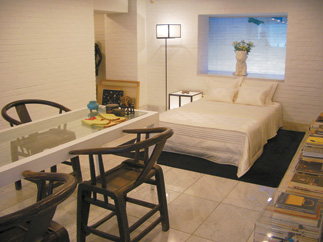
Lifestyle options for Korea’s rich and famous include an elegant bedroom featuring a silk bedding set, contemporary arts and coffee table books.
He feels that Korea has poor taste in matters of style and too few choices in design, but, as in many advanced countries, the public has just started to incorporate design into lifestyle. As an example he cites the collaboration between the celebrity fashion designer Andre Kim and Samsung refrigerators.
“There are taste hunters who want to match designers, and companies and a tasteful and selective designer can suggest a certain style for electronic goods, china, silverware or bedding in volume businesses,” he said. “And there definitely is a market for it.” In other words, Mr. Suh may be descending from his Namsan aerie soon to bring haute style to the masses and make some jaebeol money of his own.
By Ines cho Staff Writer [inescho@joongang.co.kr]










with the Korea JoongAng Daily
To write comments, please log in to one of the accounts.
Standards Board Policy (0/250자)